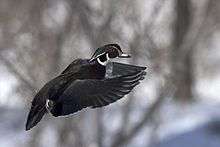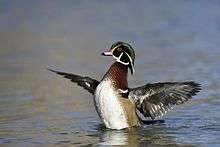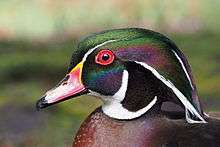Wood duck
| Wood duck | |
|---|---|
%2C_Parc_du_Rouge-Clo%C3%AEtre%2C_Brussels.jpg) | |
| Male wood duck | |
%2C_Parc_du_Rouge-Clo%C3%AEtre%2C_Brussels.jpg) | |
| Female wood duck | |
| Scientific classification | |
| Kingdom: | Animalia |
| Phylum: | Chordata |
| Class: | Aves |
| Order: | Anseriformes |
| Family: | Anatidae |
| Genus: | Aix |
| Species: | A. sponsa |
| Binomial name | |
| Aix sponsa (Linnaeus, 1758) | |
| | |
| Range of A. sponsa Breeding range Year-round range Wintering range | |
| Synonyms | |
| |
The wood duck or Carolina duck (Aix sponsa) is a species of perching duck found in North America. It is one of the most colorful North American waterfowl.[2][3]



Description

 |
Call
Several Wood Ducks calling |
| Problems playing this file? See media help. | |
The wood duck is a medium-sized perching duck. A typical adult is from 47 to 54 cm (19 to 21 in) in length with a wingspan of between 66 to 73 cm (26 to 29 in). This is about three-quarters of the length of an adult mallard. It shares its genus with the Asian Mandarin duck (Aix galericulata).[2]
The adult male has distinctive multicolored iridescent plumage and red eyes,with a distinctive white flare down the neck. The female, less colorful, has a white eye-ring and a whitish throat. Both adults have crested heads.
The male's call is a rising whistle, jeeeeee; the females utter a drawn-out, rising squeal, do weep do weep, when flushed, and a sharp cr-r-ek, cr-e-ek for an alarm call.[4]
Behavior
Their breeding habitat is wooded swamps, shallow lakes, marshes or ponds, and creeks in eastern North America, the west coast of the United States and western Mexico. They usually nest in cavities in trees close to water, although they will take advantage of nesting boxes in wetland locations if available. Females line their nests with feathers and other soft materials, and the elevation provides some protection from predators.[5] Unlike most other ducks, the wood duck has sharp claws for perching in trees and can, in southern regions, produce two broods in a single season—the only North American duck that can do so.[4]
Females typically lay between 7 and 15 white-tan eggs that incubate for an average of 30 days.[4] However, if nesting boxes are placed too close together, females may lay eggs in the nests of their neighbours, which may lead to nests which may contain as many as 30 eggs and unsuccessful incubation, a behaviour known as "nest dumping".[6]
After hatching, the ducklings jump down from the nest tree and make their way to water. The mother calls them to her, but does not help them in any way.[5] They prefer nesting over water so the young have a soft landing, but will nest up to 140 m (460 ft) away from the shoreline. The day after they hatch, the young climb to the nest entrance and jump to the ground. The ducklings can swim and find their own food by this time."
These birds feed by dabbling or walking on land. They mainly eat berries, acorns, and seeds, but also insects, making them omnivores.[5]
Distribution

The birds are year-round residents in parts of its southern range, but the northern populations migrate south for the winter.[7][8] They overwinter in the southern United States near the Atlantic coast. 75% of the wood ducks in the Pacific Flyway are non-migratory.[8] They are also popular, due to their attractive plumage, in waterfowl collections and as such are frequently recorded in Great Britain as escapes—populations have become temporarily established in Surrey in the past but are not considered to be self-sustaining in the fashion of the closely related Mandarin duck. Given its native distribution the species is also a potential natural vagrant to Western Europe and there have been records in areas such as Cornwall, Scotland and the Isles of Scilly which some observers consider may relate to wild birds; however, given the wood duck's popularity in captivity it would be extremely difficult to prove their provenance one way or another. There is a small feral population in Dublin.
Conservation
The population of the wood duck was in serious decline in the late 19th century as a result of severe habitat loss and market hunting both for meat and plumage for the ladies' hat market in Europe. By the beginning of the 20th century, wood ducks had virtually disappeared from much of their former range. In response to the Migratory Bird Treaty established in 1916 and enactment of the U.S. Migratory Bird Treaty Act of 1918, wood duck populations began to recover slowly. By ending unregulated hunting and taking measures to protect remaining habitat, wood duck populations began to rebound in the 1920s. The development of the artificial nesting box in the 1930s gave an additional boost to wood duck production.[9]
Landowners as well as park and refuge managers can encourage wood ducks by building wood duck nest boxes near lakes, ponds, and streams. Fulda, Minnesota has adopted the wood duck as an unofficial mascot, and a large number of nest boxes can be found in the area.
Expanding North American beaver populations throughout the wood duck's range have also helped the population rebound as beavers create an ideal forested wetland habitat for wood ducks.[8]
The population of the wood duck has increased a great deal in the last several years. The increase has been due to the work of many people constructing wood duck boxes and conserving vital habitat for the wood ducks to breed. During the open waterfowl season, U.S. hunters have only been allowed to take two wood ducks per day in the Atlantic and Mississippi Flyways. However, for the 2008–2009 season, the limit was raised to three. The wood duck limit remains at two in the Central Flyway and at seven in the Pacific Flyway. It is the second most commonly hunted duck in North America, after the mallard.[2]
In popular culture
In 2013, the Royal Canadian Mint created two coins to commemorate the wood duck. The two coins are each part of a three coin set to help promote Ducks Unlimited Canada as well as celebrate its 75th anniversary.[10]
Gallery
 Pair
Pair%2C_Parc_du_Rouge-Clo%C3%AEtre%2C_Brussels.jpg) Male
Male Taking off from ice
Taking off from ice Male in eclipse plumage
Male in eclipse plumage Duckling
Duckling.jpg) Male in profile
Male in profile- Male wood duck profile
 Male grooming himself
Male grooming himself Male in flight profile
Male in flight profile Male on ground
Male on ground Male taking off to fly
Male taking off to fly
References
- ↑ BirdLife International (2012). "Aix sponsa". IUCN Red List of Threatened Species. Version 2014.3. International Union for Conservation of Nature. Retrieved 1 December 2014.
- 1 2 3 "Wood Duck". All About Birds. Cornell Lab of Ornithology. Retrieved 9 July 2010.
- ↑ Dawson, William (2007). Neher, Anna, ed. Dawson's Avian Kingdom Selected Writings. California Legacy. pp. 37–38. ISBN 978-1-59714-062-1.
- 1 2 3 "Wood Duck". Ducks Unlimited Canada. Retrieved 1 December 2014.
- 1 2 3 "Wood Duck Fact Sheet, Lincoln Park Zoo". lpzoo.org. Retrieved 24 August 2013.
- ↑ "Wood Duck (Aix sponsa) Dump-Nests". Northern Prairie Wildlife Research Center. Retrieved 13 January 2012.
- ↑ "Wood Duck". Hinterland's Who's Who. Retrieved 1 December 2014.
- 1 2 3 "Wood Duck". BirdWeb: The Birds of Washington State. Seattle Audubon Society. Retrieved 9 July 2010.
- ↑ Wood Duck (Aix sponsa) (PDF) (Report). USDA Natural Resources Conservation Service. Retrieved 9 July 2010.
- ↑ "Royal Canadian Mint Coins Celebrate the 75th Anniversary of Ducks Unlimited Canada While Honouring Other Icons of Canadian Nature, Culture And History". Mint.ca. 6 March 2013. Retrieved 2013-08-24.
External links
| Wikimedia Commons has media related to Aix sponsa. |
| Wikispecies has information related to: Aix sponsa |
- Wood Duck Society
- BirdLife species factsheet for Aix sponsa
- "Wood Duck media". Internet Bird Collection.
- Wood duck photo gallery at VIREO (Drexel University)
